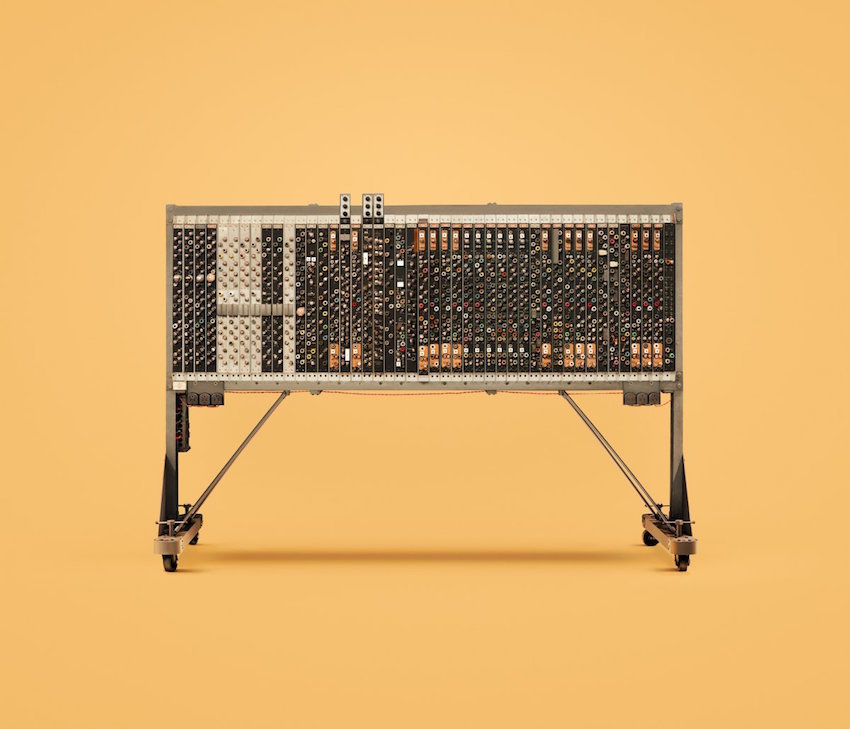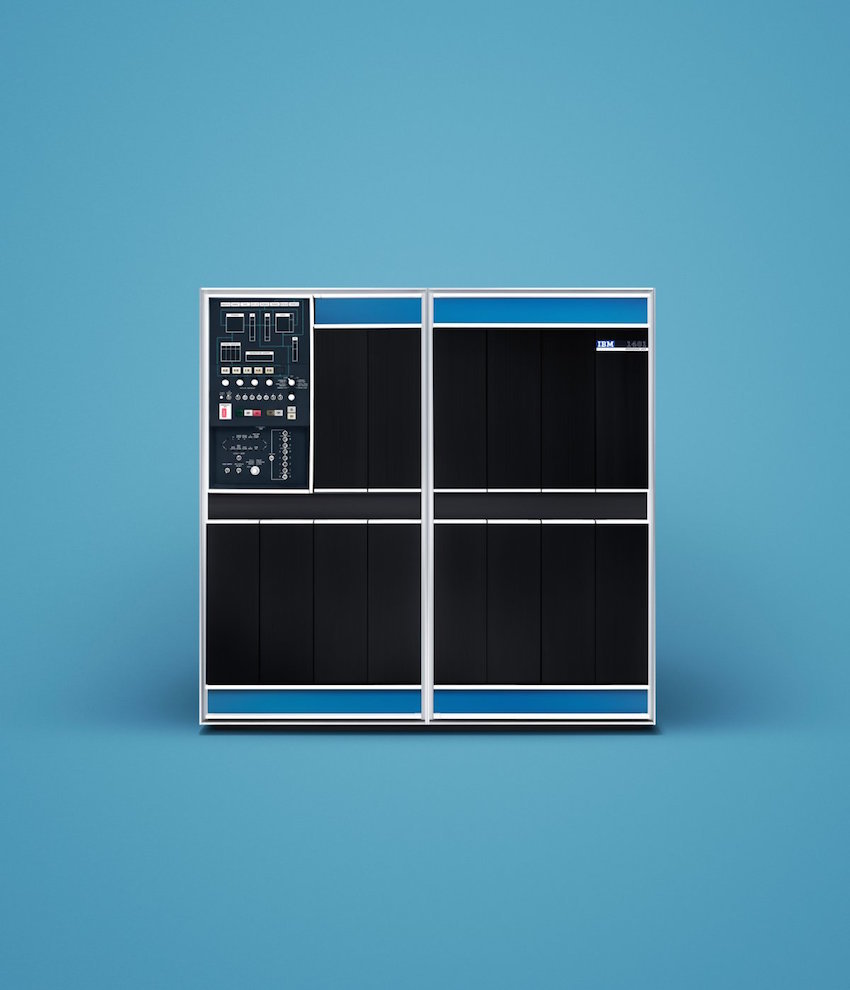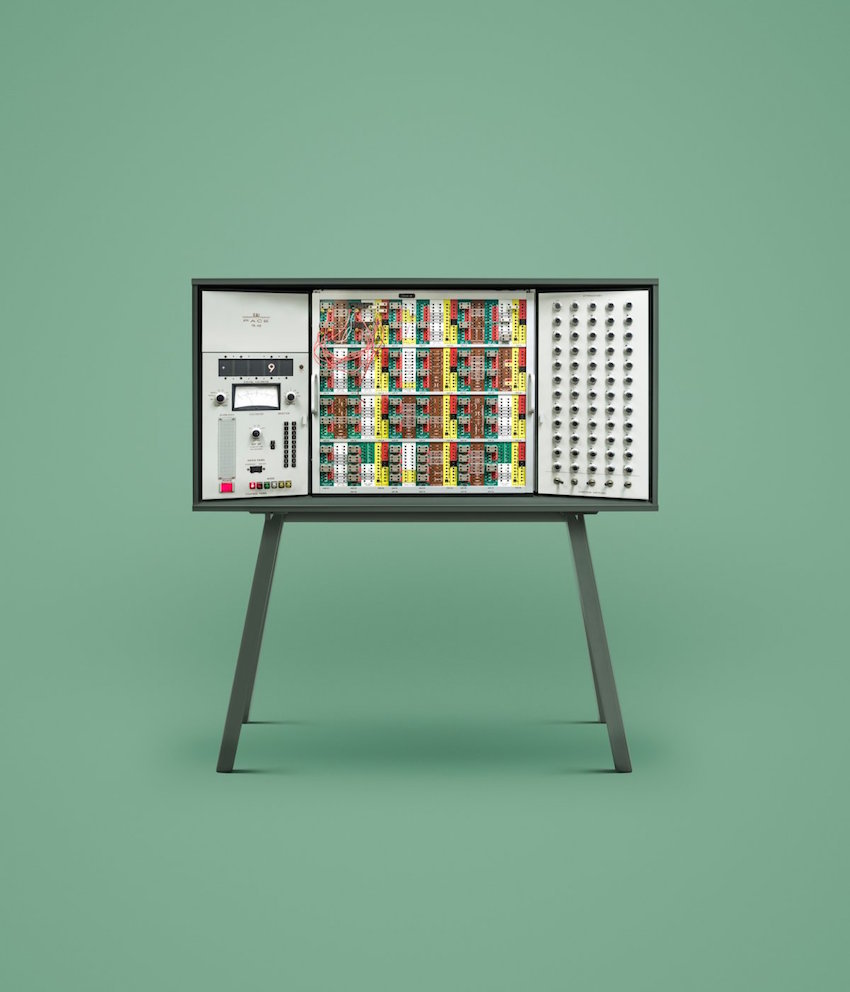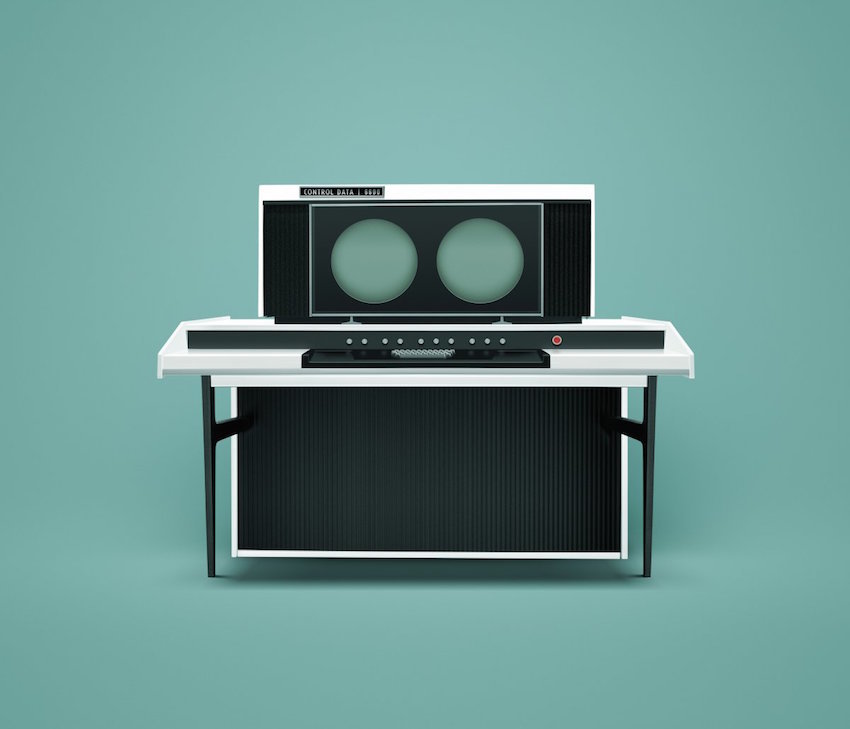Legendary history computers
The first computers occupied a huge amount of space and consumed a lot of energy, while having very limited functionality. But the technological revolution has made computers elegant, compact and light, providing them with additional devices and equipment. Modern computers are very contrasted with the "huge things" of the past years.
English photographer James Ball (James Ball), also known as 'Docubyte', has always had a particular interest in the very first computers:
Paying tribute to his passion, the photographer decided to create a colorful series of photographs of old computers with historical information about each of them. According to him, black and white photographs are not able to fully convey the magnificence of these machines.

Harwell decatron
Ball conducted research and found the location of interest to his computers. Most of them have long been in museums. The photographer made an official request to the management of the museums in order to present in a new, unusual way the machines that changed the development of technologies.
The British computer Harwell Dekatron was created in 1951. He weighed more than 2.7 small (short) tons of 907 kilograms each, worked for a relay and was considered a full-fledged computer with a stored program. Volatile memory was built on decatrons, and data were output on punched tape or teletype. The internal memory consisted of 20 8-bit decimal registers, but over time increased to 40. A significant drawback of the computer was its low computational power.
Harwell Dekatron was in operation until 1957.
At the end of 2009, the TNMOC volunteer team used its ingenuity and reengineering skills to restore this record computer. In 2012, Harwell Dekatron was renovated at the National Museum of Computer Technology Bletchley Park as part of a project of the Society for the Preservation of Computers. The computer was listed in the Guinness Book of Records as the "oldest functional electronic computer with a stored program."

Pilot ACE - one of the first British computers, developed by Alan Turing (Alan Turing) in the National Physical Laboratory of Great Britain (National Physical Laboratory, NPL) in the early 50s. It was also one of the very first computers with a stored program, like other British projects like Manchester’s Mark I and EDSAC .
Pilot ACE contained almost 800 vacuum tubes and made floating-point calculations necessary for many scientific studies. The initial amount of memory was 128 words, 32 bits each, but later it was expanded to 352 words. In 1954, a magnetic drum with a volume of 4096 words was added. The computer worked at a design clock frequency of 1 MHz and was the fastest British computer of the time. The speed of execution of instructions depended heavily on their location in memory. The addition operation took from 64 to 1024 microseconds.

The IBM 1401 is a computer with a variable word length, announced on October 5, 1959 by IBM. This computer was the first successful IBM 1400 series mainframe computer and was especially popular in its time. The success of the model contributed to the memory on the magnetic cores (ferrite memory) for 4000 characters, which stores data on small magnetized ferrite rings (cores).
The IBM 1401 was discontinued in 1971, and more than 12,000 computers have been manufactured.
But in 2013, IBM 1401 was restored by a group of 1401and employees of the Computer History Museum, CHM. The museum opened a new exhibition IBM 1401 Demo Lab, which included not only the computer itself, but also peripheral devices, including drills, printers, tape drives.

The IBM 729 with a magnetic tape unit was a cult company computer with a tape storage system from the late 50s to the mid 60s.
He used magnetic tapes up to 2,400 feet (731 meters), which were wound on drums up to 10.5 inches (26 centimeters).

EAI Pace (TR 48) is a “desktop computer” that was produced in the early 60s. With 4 feet (1.21 meters) wide and just over 2 feet (60 centimeters) tall, its weight fluctuated between 320 and 425 pounds (145-192 kilograms) depending on the configuration.
From the TR 48 Instruction Manual:
PACE TR 48 is a transistor-assembled analogue general-purpose computer. It consists of elements of a solid-state scheme, compact in size and suitable for desktop installation. The computer is able to work stably and smoothly in normal office conditions; power requirements are small, so the TR 48 does not need large main power systems or special cooling systems.
The TR 48 was the most complete desktop analog computer of its time and was even used as part of the Apollo program (a manned landing on the moon in 1975). In the 70s, it was also used to simulate stars and their movements, which made it possible to test the astronaut system used by the Apollo astronauts. The official report has an interesting detail: the astronaut system aboard the Apollo used an early microprocessor Intel 8080.

The CDC 6600 is the first successful supercomputer with a capacity of up to three megaflops. From 1964 to 1969 was considered the fastest in the world. Developed by Control Data Corporation in 1963 under the leadership of the legendary American engineer in the field of computing technology, the creator of a number of American supercomputers Seymour Cray. He is also considered the "father of supercomputers."
The CDC 6600 was 3 times faster than its main rival, the IBM Stretch computer. The cost of the machine Kray was lower - a little more than $ 7 million (when IBM Stretch was worth $ 13 million). On this occasion, on August 28, 1963, IBM J. Thomas Watson, CEO of IBM, wrote to his staff:

Endim 2000 is an analog computer designed and built in the former German Democratic Republic. All were released about 20 cars. The surviving models are on display in the German Technische Museum Sammlungen Dresden.

Meda 42TA - one of the latest analog hybrid computers of the former Czechoslovakia, created in the early 70s. Widely used in many countries outside the Iron Curtain.

HDR 75 is a small analog hybrid computer that was developed in the former GDR at the Technical University of Dresden, now known as the Center for Information Services and High Performance Computing (Center for Information Services and High Performance Computing).

Computers of the 7500 series were developed in the 70s by ICL (now does not exist). The machines were intended for use in the office, with a steel frame and wooden veneered cabinets that housed processors and peripherals.
By the 1980s, highly specialized versions of the CL 7500 could launch various games available for that time, such as PacMan and Space Invaders.
At the heart of the post translation of the article , if possible supplemented with information.
English photographer James Ball (James Ball), also known as 'Docubyte', has always had a particular interest in the very first computers:
I love to look at pictures of vintage computers that allowed us to use the benefits of computerization that we have.
Paying tribute to his passion, the photographer decided to create a colorful series of photographs of old computers with historical information about each of them. According to him, black and white photographs are not able to fully convey the magnificence of these machines.

Harwell decatron
Ball conducted research and found the location of interest to his computers. Most of them have long been in museums. The photographer made an official request to the management of the museums in order to present in a new, unusual way the machines that changed the development of technologies.
Harwell decatron
The British computer Harwell Dekatron was created in 1951. He weighed more than 2.7 small (short) tons of 907 kilograms each, worked for a relay and was considered a full-fledged computer with a stored program. Volatile memory was built on decatrons, and data were output on punched tape or teletype. The internal memory consisted of 20 8-bit decimal registers, but over time increased to 40. A significant drawback of the computer was its low computational power.
Harwell Dekatron was in operation until 1957.
At the end of 2009, the TNMOC volunteer team used its ingenuity and reengineering skills to restore this record computer. In 2012, Harwell Dekatron was renovated at the National Museum of Computer Technology Bletchley Park as part of a project of the Society for the Preservation of Computers. The computer was listed in the Guinness Book of Records as the "oldest functional electronic computer with a stored program."
Pilot ACE

Pilot ACE - one of the first British computers, developed by Alan Turing (Alan Turing) in the National Physical Laboratory of Great Britain (National Physical Laboratory, NPL) in the early 50s. It was also one of the very first computers with a stored program, like other British projects like Manchester’s Mark I and EDSAC .
Pilot ACE contained almost 800 vacuum tubes and made floating-point calculations necessary for many scientific studies. The initial amount of memory was 128 words, 32 bits each, but later it was expanded to 352 words. In 1954, a magnetic drum with a volume of 4096 words was added. The computer worked at a design clock frequency of 1 MHz and was the fastest British computer of the time. The speed of execution of instructions depended heavily on their location in memory. The addition operation took from 64 to 1024 microseconds.
IBM 1401

The IBM 1401 is a computer with a variable word length, announced on October 5, 1959 by IBM. This computer was the first successful IBM 1400 series mainframe computer and was especially popular in its time. The success of the model contributed to the memory on the magnetic cores (ferrite memory) for 4000 characters, which stores data on small magnetized ferrite rings (cores).
The IBM 1401 was discontinued in 1971, and more than 12,000 computers have been manufactured.
But in 2013, IBM 1401 was restored by a group of 1401and employees of the Computer History Museum, CHM. The museum opened a new exhibition IBM 1401 Demo Lab, which included not only the computer itself, but also peripheral devices, including drills, printers, tape drives.
IBM 729

The IBM 729 with a magnetic tape unit was a cult company computer with a tape storage system from the late 50s to the mid 60s.
He used magnetic tapes up to 2,400 feet (731 meters), which were wound on drums up to 10.5 inches (26 centimeters).
EAI Pace (TR 48)

EAI Pace (TR 48) is a “desktop computer” that was produced in the early 60s. With 4 feet (1.21 meters) wide and just over 2 feet (60 centimeters) tall, its weight fluctuated between 320 and 425 pounds (145-192 kilograms) depending on the configuration.
From the TR 48 Instruction Manual:
PACE TR 48 is a transistor-assembled analogue general-purpose computer. It consists of elements of a solid-state scheme, compact in size and suitable for desktop installation. The computer is able to work stably and smoothly in normal office conditions; power requirements are small, so the TR 48 does not need large main power systems or special cooling systems.
The TR 48 was the most complete desktop analog computer of its time and was even used as part of the Apollo program (a manned landing on the moon in 1975). In the 70s, it was also used to simulate stars and their movements, which made it possible to test the astronaut system used by the Apollo astronauts. The official report has an interesting detail: the astronaut system aboard the Apollo used an early microprocessor Intel 8080.
Control Data 6600

The CDC 6600 is the first successful supercomputer with a capacity of up to three megaflops. From 1964 to 1969 was considered the fastest in the world. Developed by Control Data Corporation in 1963 under the leadership of the legendary American engineer in the field of computing technology, the creator of a number of American supercomputers Seymour Cray. He is also considered the "father of supercomputers."
The CDC 6600 was 3 times faster than its main rival, the IBM Stretch computer. The cost of the machine Kray was lower - a little more than $ 7 million (when IBM Stretch was worth $ 13 million). On this occasion, on August 28, 1963, IBM J. Thomas Watson, CEO of IBM, wrote to his staff:
Last week, Control Data held a press conference ... and announced the release of its 6600 system. As far as I know, there are only 34 people working in their laboratory, including the doorman. Of these, 14 are engineers, 4 are programmers. And only one person has a doctorate degree. Comparing this modest team with our vast headquarters of developers, I cannot understand how we lost the leadership in our field and allowed someone else to release the fastest computer in the world.
Endim 2000

Endim 2000 is an analog computer designed and built in the former German Democratic Republic. All were released about 20 cars. The surviving models are on display in the German Technische Museum Sammlungen Dresden.
Meda 42TA

Meda 42TA - one of the latest analog hybrid computers of the former Czechoslovakia, created in the early 70s. Widely used in many countries outside the Iron Curtain.
HDR 75

HDR 75 is a small analog hybrid computer that was developed in the former GDR at the Technical University of Dresden, now known as the Center for Information Services and High Performance Computing (Center for Information Services and High Performance Computing).
ICL 7500

Computers of the 7500 series were developed in the 70s by ICL (now does not exist). The machines were intended for use in the office, with a steel frame and wooden veneered cabinets that housed processors and peripherals.
By the 1980s, highly specialized versions of the CL 7500 could launch various games available for that time, such as PacMan and Space Invaders.
At the heart of the post translation of the article , if possible supplemented with information.
